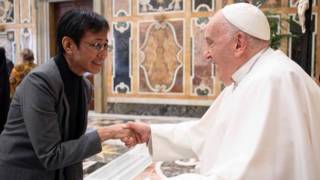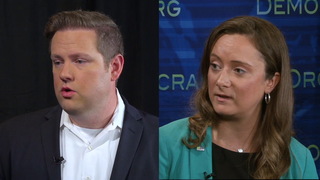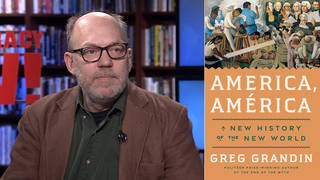
Guests
- Kristina WilforeExecutive Director of the Ballot Initiative Strategy Center. She is one of the country’s leading experts on state policy and elections.
- Richard Kimassociate editor at The Nation. He writes frequently about race, sexuality and popular culture. Kim is a co-editor of the forthcoming anthology A New Queer Agenda, published by NYU Press.
While the media focuses primarily on the presidential race, we get an overview of some of the 153 ballot initiatives being voted today in thirty-six states. Voters will weigh in on matters as diverse as clean energy, children’s health insurance, stem cell research, predatory lending, affirmative action, immigrant rights, abortion, gay marriage, adoption, nonviolent drug offenses, income tax, and treatment of farm animals. We speak with Kristina Wilfore of the Ballot Initiative Strategy Center and Richard Kim of The Nation magazine. [includes rush transcript]
Transcript
AMY GOODMAN: As we continue to look at this record number of voters heading to the polls today, we’re going to look now at some of the 153 initiatives on ballots in thirty-six states. The ballot initiatives this year cover a wide range of issues and are funded by a variety of interests.
Voters around the country will weigh in today on how their state should deal with matters, well, as diverse as clean energy, children’s health insurance, stem cell research, predatory lending, affirmative action, immigrant rights, abortion, gay marriage, adoption, nonviolent drug offenses, income tax, treatment of farm animals.
Kristina Wilfore is with us now. She’s the executive director of the Ballot Initiative Strategy Center that tracks ballot initiatives across the country and supports progressive ballot initiative campaigns. She joins me on the phone from — well, are you voting right now, Kristina?
KRISTINA WILFORE: Luckily, I just got out of there. The polls opened here in Washington, D.C. — I’m on Capitol Hill — at 7:00. There was already about 200 people in line at 7:10. And luckily, they pulled the T-through-Zs ahead, so I was able to skirt much of that. But it’s going to be a long day here in the District.
AMY GOODMAN: Well, why don’t you talk about what you see as some of the key ballot initiatives? There’s so much focus on the presidential race that I think when people go to their polling precinct and they look at the polling machine and they see a ballot initiative on it, some will not even know what it’s about .
KRISTINA WILFORE: Mm-hmm, yeah. It certainly, especially this year, gets a little lost in some of the things that are of, you know, more dominance. It’s fascinating, especially in the last week, you see more coverage related to some of the more eclectic and controversial kinds of issues around animal rights or the drug reform or criminal justice issues, and those are an annual part of the ballot.
But what is a little lost in that attention to those measures is some real fundamental issues that we believe are present this cycle, because people really have big problems and want big solutions, around healthcare, clean and reliable energy, and issues that are more core to what people wake up in the night worrying about. And so, from some that you mentioned, around children’s healthcare, home care authorities, creating those in Washington and Missouri, stem cell research, and then everything from alternative fuels in California to clean and solar energy, oil severance tax — there’s a variety of issues that are really fundamental to the kinds of things that we know voters are worried about and want to see real progress on.
AMY GOODMAN: Kristina Wilfore, we’re going to break and then come back. We’ll also be joined by Richard Kim of The Nation and look more closely at some of these ballot initiatives. This is Democracy Now!, democracynow.org, the War and Peace Report. Back in a minute.
[break]
AMY GOODMAN: Kristina Wilfore with us, looking at ballot initiatives. We’re also joined in our firehouse studio by Richard Kim, associate editor at The Nation magazine, writes frequently about race, sexuality, popular culture, just returned from California, where he’s following the battle over Prop 8, that seeks a constitutional amendment to ban gay marriage.
Anti-gay marriage initiatives that seek to define marriage as exclusively between a man and a woman are also on the ballot in Arizona and Florida. But the campaign to pass California’s Proposition 8 is by far the most expensive and eclipses even the most expensive Senate race this year.
Richard Kim, welcome to Democracy Now!
RICHARD KIM: Hi, Amy.
AMY GOODMAN: Let’s talk about this Proposition 8.
RICHARD KIM: You know, it’s an extraordinary thing out in California. It’s almost as if the presidential race is not happening. You drive around, and all you see are Prop 8 signs. Both sides combined will have raised about $70 million — some people are now saying $75 million — for this. So it’s an incredibly, you know, heated thing in California.
What I’m seeing on the ground is that the gay and lesbian groups have been a little bit slow to do outreach to minority communities, to multi-faith communities. The right wing here was incredibly mobilized from the get-go. They have raised a lot of money from out of state, including $1.4 million from the Knights of Columbus, over half-a-million dollars from Elsa Prince, the mother of Blackwater founder Erik Prince. And they have made real inroads into minority communities. I was in LA City Hall on Sunday, and I was at a 2,000, mostly Chinese, rally for Prop 8, you know, lots of kids, “protect mommy and daddy” t-shirts on. So it’s a little bit disturbing. I don’t know how it’s going to break.
AMY GOODMAN: Let’s turn to some of the ads for Prop 8.
LITTLE GIRL: Can boys ever have babies?
FATHER: No, dear, only mommies.
LITTLE GIRL: Megan says you have to have a mommy and a daddy to have a baby.
FATHER: Maybe we should spend a little less time over at Megan’s house.
YES ON PROP 8 AD: Let’s not confuse our kids. Protect marriage by protecting the real meaning of marriage: only between a man and woman. Vote yes on Proposition 8.
LITTLE GIRL: Mom, guess what I learned in school today.
MOTHER: What, sweetie?
LITTLE GIRL: I learned how a prince married a prince, and I can marry a princess.
PROF. RICHARD PETERSON: Think it can’t happen? It’s already happened.
ROBIN WIRTHLIN: After Massachusetts legalized gay marriage, our son came home and told us the school taught him that boys can marry other boys. He’s in second grade.
ROBB WIRTHLIN: We tried to stop public schools from teaching children about gay marriage, but the court said we had no right to object.
NEWT GINGRICH: Our courts have an important role to play in our government, but it is not their role to define American values. That right belongs with the people. As you know, in 2000, California voters went to the polls and voted overwhelmingly in favor of legally protecting marriage. Earlier this year, four judges overruled the will of the people and declared the law that protected marriage unconstitutional. Think about that. Four appointed lawyers — that’s all judges are — overruled more than four million California voters.
YES ON PROP 8 AD: It’s no longer about tolerance. Acceptance of gay marriage is now mandatory.
PROF. RICHARD PETERSON: That changes a lot of things. People sued over personal beliefs. Churches could lose their tax exemption. Gay marriage taught in public schools.
YES ON PROP 8 AD: We don’t have to accept this.
UNIDENTIFIED MAN: Whether you like it or not.
YES ON PROP 8 AD: Yes on 8.
AMY GOODMAN: A medley of some of the advertisements. Kristina Wilfore, you have written about the Mormon Church on Prop 8.
KRISTINA WILFORE: Yeah, and that’s what I think we have to look at, what kind of campaign are they running, which I would say is low road. You know, over — and I’ll speak to the Mormon Church in a second, but over the weekend, I heard that the pro-Prop 8 campaign did a mailer into minority communities, using the image of Obama and quotes about civil unions. Now, he has actually come out against Prop 8. Regardless of how he feels about civil unions, I believe, from what we’ve heard from him, he doesn’t believe that we should take existing rights away, which this California measure would do.
As far as the Mormon money, at least two weeks ago, 44 percent of the total money raised was coming from members of the Mormon Church. And I think that’s a very dangerous road for them to go down. You know, several producers of anti-gay propaganda also market anti-Mormon propaganda, materials labeled by the church as slanderous and hateful, including titles by California-based video company Jeremiah Films such as The God Makers
, which calls Mormonism a cult bent on global domination. So, you know, why is the Mormon Church involved? They have never been this significantly involved, both in California and Arizona, where they’ve given over $4 million to that effort, which was already voted on by voters. You know, why are they leading the charge to rewrite California’s constitution? And I think the choice is very clear for voters: do believe the Mormon Church shares your values on marriage, or do you believe the constitution should treat everyone equally?
AMY GOODMAN: Richard Kim, on the issue, the black community is divided on Prop 8, on the anti-gay marriage initiative.
RICHARD KIM: Well, some of the polling over the fall was showing that the majority of black voters were for Prop 8. That’s actually moved very recently. There was an ad that the No on Prop 8 people did. It’s narrated by Samuel L. Jackson. A whole host of black community leaders have come out and done outreach in their community. So I actually think that’s tipping, I hope, today; you’ll actually see the majority of African American and the majority of Latino voters vote no on 8.
They’ve done a very good job of linking this kind of discrimination to Japanese internment, to anti-miscegenation laws, to redlining in California. The big ad that they’re running now focuses on that, and it’s put forward minority voices. So, you know, I’m optimistic. You know, looking at those ads, I will also say that, you know, the whole Yes on 8 campaign has really dissembled around the issue of secularism, right? So in a secular democracy, many faiths can decide what marriage means for them. Nobody is going to be forced to marry gays and lesbians in their church. What the Mormon Church, the Catholic Church and the evangelical churches are asking for is basically monopoly power to enforce their view of marriage on the entire population.
AMY GOODMAN: What would it mean if it passed for married couples, gay couples, in California?
RICHARD KIM: Right. Most legal experts — and there have been about 14,000 gay and lesbian couples who were married. I saw maybe seven different gay and lesbian weddings in my thirty-six hours there, right? So, 14,000 people. Most legal experts say that those cannot be invalidated by this. And in fact, you know, the tricky thing here is that before marriage, same-sex marriage, was authorized by the courts, there was already domestic partnership law on the books that gave all the rights that a state can give, absent federal marriage, to gay and lesbian couples. So, in some ways, this is a symbolic fight, you know, but marriage does matter a lot to people, and politically, you know, it really is about a right-wing base turning out and try to exercise their power versus —-
AMY GOODMAN: And we saw Newt Gingrich in that ad.
RICHARD KIM: Absolutely.
AMY GOODMAN: And wasn’t it used in the last election as a way to get people out who might not have been so motivated to come out before, but if they could vote against gay marriage, then you go up the ticket of the presidential, senator, you know, congressional races, and you’ll vote a certain way?
RICHARD KIM: Right, absolutely. And this is really the top of the ticket in California. There’s not a gubernatorial race. There’s not a Senate race. This is really the big race there. And that’s -— you know, in every sort of election where there’s a sea change, the other side entrenches, and that’s what they’re really trying to do with this in California.
AMY GOODMAN: You’ve been following reproductive rights cases, as well? Ballot initiatives?
RICHARD KIM: I’ve been following a little bit the — I think it’s called Prop 4 there, but not all that closely. You know, what I am seeing is actually a kind of synergy between the parental notification amendment there in California and the anti-gay one, but the anti-gay one is definitely in the lead in California.
AMY GOODMAN: Kristina Wilfore, talk about reproductive rights initiatives around the country.
KRISTINA WILFORE: Well, we have two others outside of California. So you have the redefinition of the person and the egg, in essence making the egg the rights of person in Colorado, and then you have the abortion ban again in South Dakota. Now, it’s described as having exceptions, but even OB/GYN doctors have said, “Look, with 2,400 words in this law, the exceptions are so vaguely written, there’s no way anyone is going to risk providing an abortion to a woman who needs this and risk going to jail.”
But what’s been fascinating this year is that many of the ballot measures that we saw, and there were an additional four that attempted to qualify in different states — Montana, Missouri, Georgia and Oregon —- that failed to take hold at the signature-gathering level, and I think because many of these ideas are extreme and out of the priorities that we need for women’s reproductive health and freedom. And so, we have really seen a lot of fissures, in fact, even between the anti-choice movement itself, where Colorado Right to Life was kicked out of National Right to Life for their pursuit of this measure. And you even had Bob Schaffer run away from it a couple months ago, you know, realizing that he needed independent and Republican women who eschew such over—, far-reaching kinds of measures.
So, you know, Colorado will likely go down; South Dakota, you know, it’s going to be close. We had a staff member on the ground there over the last few days, and they’re doing as much education and door-to-door as they can. But they don’t have the resources that they did in 2006, and it is a very conservative state that, by the way, already has the most amount of restrictions existing on abortion and access to abortion. So this is a test case for the right wing. They’re trying to get to Roe. That’s where they ultimately want to go with these ballot measures. But in some places, they may just be a bit too much for voters.
AMY GOODMAN: And in all these ballot initiatives — and we’re going to show a series of maps now for our TV viewers; for radio listeners, you can go to our website to see them, at democracynow.org — you’ve got the states that have these initiatives, and then the ones with the ban sign, the prohibition sign, are the ones where the initiative actually failed to get on the ballot.
KRISTINA WILFORE: Mm-hmm. It was in several states, where they failed. And, you know, that’s what I think many of these ballot measures come down to. In fact, there was twenty-nine right-wing initiatives that were poised to be on the ballot eight months ago, where they just failed to take fire at the signature-gathering stage. And that’s remarkable. I’ve been tracking and working on ballot measures for over seven years, and I’ve never seen where they have momentum and money that they actually fail to qualify. And that’s because, I believe, many of these extreme measures are exactly that, extreme. You know, and these right-wing efforts on the ballot to divide and distract voters are just not what people want in a “change versus more of the same” kind of election.
AMY GOODMAN: Can you talk about ballot initiatives involving workers, Kristina Wilfore?
KRISTINA WILFORE: Mm-hmm. Well, there are several. You know, the workers and the voice of workers and political participation of workers has been under attack in several states. Colorado, I just got back from last night, where there are three ballot measures that are a mix of what’s called “Right to Work” — we call it “Right to Work for Less” — Paycheck Deception and a new version of that called “Open and Clean.” There are several similar measures in Oregon. There is also the so-called Open and Clean, which has to do with limiting who can participate in political campaigns if they have a sole-source contract with the state. But essentially, it’s aimed at labor, although in this case, in South Dakota, even the Chamber of Commerce opposes it, because it goes after business interests, too.
You know, much of these efforts, I think, we’ll have to see how they turn out, but I believe the anti-labor forces out there may want to be careful about what it is they do to sort of pull the tail of the tiger here and activate union members around these very, you know, divisive issues. And, you know, I think that we’ll see more political sort of consequences of having — giving labor an excuse to be even that much more organized in these states, where they’re, I believe, going to have some significant victories politically. So, you know, these measures are out of step with what we know we need in an economy that’s struggling right now. They go against the interests of building economic security and support for workers. And I think voters will see it that way.
AMY GOODMAN: The education initiatives, can you describe what they are, where they are?
KRISTINA WILFORE: Well, there are not as many education measures. You know, vouchers was ultimately kicked off the ballot in Florida. That would have been the most significant fight. They keep going back, state after state, even though we’re winning those. In Oregon, however, you have the elimination of bilingual education, which, you know, is a difficult measure but is, you know, looking to be out of sync with what even Oregonians say that they want. There are some local levies, and those are going to be tough fights in the tight economy, but those are the most significant, in addition to Colorado, actually, where they’re doing a fix of their very restrictive TABOR system, Taxpayer Bill of Rights, that would create a separate account for education called the SAFE initiative.
AMY GOODMAN: What about healthcare?
KRISTINA WILFORE: Healthcare is fascinating. When we did research among swing voters earlier in the cycle and really talked to them about a wide variety of ballot measures of interest, it was healthcare and clean energy that had the most intensity behind it. And so, you have a variety of measures that are attempting to give access and that don’t necessarily have huge price tags, from the stem cell research, allowing stem cell research for cures in Michigan, homecare measure in Missouri and Washington state that creates an authority to give and provide long-term and children’s homecare.
You’ve got the children’s healthcare initiative in Montana, which also really relates to what we see federally on this issue. You know, this is the first measure, and this is my home state, not wildly progressive in Montana, but we’ve got Schweitzer and Tester, and you’ve got some — you know, some interesting dynamics happening there. And while the anti-choice initiative, the abortion ban, failed to qualify, you had this embraced by voters at the signature-gathering stage. So that, I think, tells you what this dynamic to this election is sizing up to be. And we even have Senator Baucus saying, “Look, if we do this in Montana and if we pass children’s healthcare in a red state, this means that we need to go into the first hundred days of Congress and go after SCHIP again,” which was vetoed by Bush last spring.
You also have Death with Dignity, which provides opportunity for terminally ill patients to take their own choices around their terminal illness in Washington state, and a couple other, you know, smaller, under-the-radar efforts, but that really are sort of significant, I believe, in what we want and what we see voters really wanting some progress on.
AMY GOODMAN: The issue of energy, Kristina Wilfore, who heads up the Ballot Initiative Strategy Center — California, Colorado, Missouri?
KRISTINA WILFORE: Mm-hmm. I think we’re going to have more of a mixed bag. And certainly, if you look at the California measures, there is some controversy within that. But just the existence of this, we’ve never seen as many energy measures on the ballot before, and I think this relates to the fact that it connects to nearly everything that is important to voters this cycle: independence and freedom, the economy and jobs, security, a clean environment. You know, what clearly has shifted from what were more traditional just environmental sort of issues to this being a broader — that’s connected to broader sort of themes. So you have the alternative fuels measure in California with also the clean and solar energy. You know, the T. Boone Pickens measure is getting a lot of attention, because of, you know, the component of the state buying bonds.
But the Missouri measure, we’ve spent a lot of time on, which is a clean energy, setting up renewable portfolio standards. What was fascinating is that — is the polling showed that to be against that measure increased a candidate’s negative. So it was one of the most important reasons in defining candidates. And that’s what a lot of these initiatives can do. Does it provide some ability to distinguish between candidates, given their support or opposition of it? So, being for it, you know, really put a different sort of take on the candidate, that they were forward-thinking, they were interested in jobs and security for the state. And so, it’s played out that level to some degree with some of the tighter state legislative races in Missouri.
AMY GOODMAN: Well, I want to thank you, Kristina Wilfore, for joining us and giving us that map of the ballot initiatives around the country, executive director of the Ballot Initiative Strategy Center. And thanks very much to Richard Kim at the Nation Institute, and we’ll be working with The Nation tonight on our five-hour coverage of this historic election.













Media Options